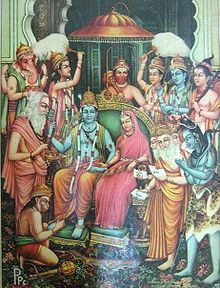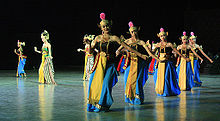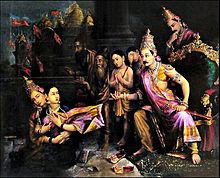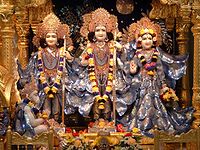- Sita
-
"Sita" redirects here. For other uses, see Sita (disambiguation).
Sita (also spelled Seeta or Seetha) (Sanskrit: सीता, "Sītā", listen:
 Sita (help·info) meaning "furrow"; ) is the wife of Rama, the seventh Avatar of Vishnu in the Hindu tradition. Sita is one of the principal characters in the Ramayana, a Hindu epic named after her husband Rama. Sita was a foundling, discovered in a furrow in a ploughed field, and for that reason is regarded as a daughter of Bhumi Devi, the goddess of the Earth. She was found and adopted by Janaka, king of Mithila, modern day Janakpur in Dhanusa district of Nepal, and his wife Sunayana. She is esteemed as the standard setter for wifely and womanly virtues for all Hindu women. Understood theologically in Hinduism, Sita is an Avatar of Lakshmi. The occasion of her marriage to Rama is celebrated as Vivaha Panchami.
Sita (help·info) meaning "furrow"; ) is the wife of Rama, the seventh Avatar of Vishnu in the Hindu tradition. Sita is one of the principal characters in the Ramayana, a Hindu epic named after her husband Rama. Sita was a foundling, discovered in a furrow in a ploughed field, and for that reason is regarded as a daughter of Bhumi Devi, the goddess of the Earth. She was found and adopted by Janaka, king of Mithila, modern day Janakpur in Dhanusa district of Nepal, and his wife Sunayana. She is esteemed as the standard setter for wifely and womanly virtues for all Hindu women. Understood theologically in Hinduism, Sita is an Avatar of Lakshmi. The occasion of her marriage to Rama is celebrated as Vivaha Panchami.Contents
Legend
Sita was a foundling, discovered in a furrow in a ploughed field, and for that reason is regarded as a daughter of Bhumi Devi, but a fact which is rarely know is that Sita was the daugher of ravan, when ravan came back from a battle he found his wife mandodri pregnant, thinking that it was not his child, he ordered to burry that unborn child inside the earth which was later discovered by Janaka, king of Mithila and his wife Sunayana. Sita was the goddess of the Earth. Upon her coming of age, a swayamwara was held to select a suitable husband for her, and she wed to Rama, prince of Ayodhya, an Avatara of Vishnu on Vivaha Panchami.
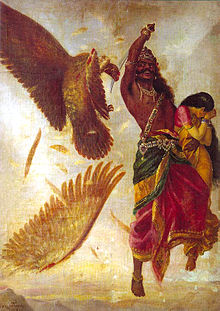 Ravana cuts off Jatayu's wing while abducting Sita, by Ravi Varma
Ravana cuts off Jatayu's wing while abducting Sita, by Ravi Varma
Exile and abduction
Main article: RamayanaSome time after the wedding, circumstances forced Rama to leave Ayodhya and spend a period of exile in the forests of Dandaka and later Panchavati. Sita willingly renounced the comforts of the palace and joined her husband in braving exile, even living in the Dandaka and Panchavati forests. The Panchavati forest became the scene for her abduction by Ravana, King of Lanka. Ravana kidnapped Sita, disguising himself as a brahmana mendicant, or begging holy-man, while her husband was away fetching a magnificent golden deer to please her. Jatayu, the vulture-king, who was a friend of Dasratha (Rama's father), tried to protect Sita but Ravana chopped off his wings. Jatayu survived long enough to inform Rama of what had happened.
Ravana took her back to his kingdom in Lanka, and Sita was held as a prisoner in one of his palaces. During her captivity for a year in Lanka, Ravana expressed his desire for her, however Sita refused his advances and struggled to maintain her chastity. Hanuman was sent by Rama to seek Sita and eventually succeeded in discovering Sita's whereabouts. Sita gave Hanuman her jewelry and asked him to give it to her husband. However, Hanuman was caught by Lankan forces. Hanuman was about to be executed and burnt in a bonfire when he managed to escape and in return burned down the Lanka capital city.
Sita was finally rescued by Rama, who waged a famous battle to defeat Ravana. Upon rescue,Rama worries about the future of human society - that any man or women may not use this as an excuse to live with each other without marriage.
The Thailand version of the Ramayana, however, tells of Sita walking on the fire, of her own accord, to feel clean, as opposed to jumping in it. She is not burnt, the coals turn to lotuses. Walking on live coals is still a common custom in the south of India.[citation needed]
In Hindu dharma, every action has results irrespective of the stature of the person. A school of thought[which?] states that Rama questioned Sita on her integrity as a punishment for her questioning the integrity of Lakshmana, who had left all his comfort and served Rama and Sita for 14 years.[citation needed]
Later life
The couple came back to Ayodhya, where Rama was crowned king with Sita by his side. While Rama's trust and affection for Sita never wavered, it soon became evident that some people in Ayodhya could not accept Sita's long captivity under the power of Ravana.
Sita's second exile
During Rama's period of rule, an intemperate washer man, while berating his wayward wife, declared that he was "no pusillanimous Rama who would take his wife back after she had lived in the house of another man". This statement was reported back to Rama, who knew that the accusation of Sita was baseless. Nevertheless, he would not let slander undermine his rule, so he drove Sita out.
Sita was thus forced into exile a second time; she was not only alone this time but also pregnant. She was rescued by the sage Valmiki. He gave her refuge in his hermitage, where she delivered twin sons named Kusha and Lava.
In the hermitage, Sita raised her sons alone, as a single mother.[1] They grew up to be valiant and intelligent, and were eventually united with their father. Once she had witnessed the acceptance of her children by Rama, Sita sought final refuge in the arms of her mother Bhumi. Hearing her plea for release from an unjust world and from a life that had rarely been happy, the earth dramatically split open; Bhumi appeared and took Sita away to a better world.
Sita's portrayal
Sita has been a much revered figure amongst the Hindus. In the blurring of the boundary between religion and mythology, between history and fiction, she has been portrayed as an ideal daughter, an ideal wife, and an ideal mother. These portrayals of her never change, and are more or less constant in various texts, stories, illustrations, and even movies and modern media.
What is ambiguous is her portrayal as an ideal queen. Was she a good states person? Was she a warrior? Her sacrifices and actions are most often portrayed in her personal capacity and not as a governance figure. Sita was abducted because she had to step out of the safety line to give alms to Ravan disguised as a Brahmin. The giving of alms to Brahmin in those times was more of a duty to be performed, rather than an optional charitable act. This held true more so for the royals and they were to lead by example. Also, the incident of Sita's refusal to come back with Hanuman like a common thief, her renunciation of queen-hood and exile from Ayodhya after her return. All her key aspects are shown in a favourable light, but not as a head of state, but as an ideal woman. This is in stark contrast to Rama, who is always portrayed also as an ideal king who was just and fair and always thought of his people before all else in addition to being depicted as an ideal husband and an ideal son.
Popular culture sees Sita as an 'abla nari or a helpless woman. She is portrayed as someone who needs support and assistance of the male folk in the myth. In fact, so enamoured were Indian Hindus in the 1950s all the way until the 1970s, that women were literally thought of as the weaker sex, unable to make decisions for themselves, unable to protect themselves, unable to foresee the consequences of their actions.
Sita as a feminist issue
Modern feminists have objections to the way the mythology of the Ramayana ends. In the myth, Sita is referred to as Sita Maiyya (Mother Sita) and the text has gone to great lengths to emphasize her 'purity' and loyalty to her husband. Feminists point out that having been depicted as a wife beyond reproach, it is unfair that she is made to undergo a 'purity test' by walking through fire. Moreover, when Sita walks through the fire unhurt, which implies that she has been faithful to her marriage vows, she is still made to go into a second exile, even in her pregnant state, as the citizens of Ayodhya are unable to accept her. The feminist argument is with only Sita being tested for her vows and not Rama even though he was without a wife and had temptations in his way. They point out that as an ideal husband, Rama should have abdicated his throne and gone with her, or that as an ideal ruler, he had to take a stand against the irrationality of the citizens and keep Sita as his queen in Ayodhya. Their point is that as the myth is taken so seriously, and part of the religion in India, having a lop-sided presentation of Sita has the effect on that society today thinks that the onus is on the woman to seem and constantly and never-endingly prove herself innocent of extramarital liaisons, and not on the male to prove her guilty.
Significance
The actions, reactions and instincts manifested by Sita at every juncture in a long and arduous life are deemed exemplary; Her story has been portrayed in the book Sitayanam.[2] The values that She enshrined and adhered to at every point in the course of a demanding life are the values of womanly virtue held sacred by countless generations of Indians.
A female deity of agricultural fertility by the name Sita was known before Valmiki's Ramayana, but was overshadowed by more well-known goddesses associated with fertility. According to the Ramayana, Sita was discovered in a furrow when Janaka was ploughing. Since Janaka was a king, it is likely that plowing was part of a royal ritual to ensure fertility of the land. Sita is considered to be the child of the Mother Earth, produced by the union between the king and the land. Sita is a personification of the Earth's fertility, abundance, and well-being.[3]
Sita's speeches in the Ramayana
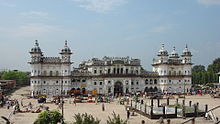 Janaki Mandir, Janakpur
Janaki Mandir, Janakpur
While the Ramayana mostly concentrates on Rama's actions, Sita also speaks many times during the exile. The first time is in the town of Chitrakuta where she narrates an ancient story to Rama, whereby Rama promises to Sita that he will never kill anybody without provocation.
The second time Sita is shown talking prominently is when she speaks to Ravana. Ravana has come to her in the form of a Brahmin and Sita tells him that he doesn't look like one.
Some of her most prominent speeches are with Hanuman when he reaches Lanka. Hanuman wants an immediate meeting of Rama and Sita, and thus he proposes to Sita to ride on his back. Sita refuses as she does not want to run away like a thief; instead she wants her husband Rama to come and defeat Ravana to save her.
When Rama wins the war, Hanuman goes to Ashok Vatika to give this news to Sita, and asks for permission to kill the female Rakshasas who have tortured her.
Names, epithets and etymology
Deities of Sita (far right), Rama (center), Lakshmana (far left) and Hanuman (below seated) at the Bhaktivedanta Manor, Watford England
Sita is known by many epithets. She is called Jānaki as the daughter of Janaka; Maithili as the princess of Mithila'; as the wife of Rāma, she is called Ramā. Her father Janaka had earned the sobriquet "Videha" due to his ability to transcend body consciousness; Sita is therefore also known as Vaidehi (Sanskrit: वैदेही)).
She is best known by the name Sita, derived from the Sanskrit word sīta, which means furrow. It is believed that her father Janaka found her while ploughing as a part of a yagna.The word was a poetic term in ancient India, its imagery redolent of fecundity and the many blessings coming from settled agriculture. The Sita of the Ramayana may have been named after a more ancient Vedic goddess Sita, who is mentioned once in the Rigveda as an earth goddess who blesses the land with good crops. In the Vedic era, She was one of the goddesses associated with fertility. A Vedic hymn recites[citation needed]:
Auspicious Sita, come thou near;
We venerate and worship thee
That thou mayst bless and prosper us
And bring us fruits abundantly.The Kausik-sutra and the Paraskara-sutra associate her repeatedly as the wife of Parjanya (a god associated with rains) and Indra.
Other uses of the name are Burmese: မယ်သီတာ [mɛ̀ θìdà]; Indonesian: Dewi Shinta, Dewi Shinto; Javanese: Senta; Khmer: នាង សីដា?, Neang Seta; Lao: ນກະງ ສກະນດກະ, Nang Sanda; Malay: Siti Dewi; Maranao: Malaila Tihaia or Malano Tihaia; Tagalog: Gandingan; Tamil: Sitai; Thai: นางสีดา, Nang Sida
Other legends
Two other legends obtaining in certain versions of the Ramayana may be mentioned in connection with Sita. These legends are significant in that they do not endorse the mainstream view of Sita having been an avatara of the goddess Lakshmi.
Vedavati
Some versions of the Ramayana suggest that Sita was a reincarnation of Vedavati (an avatar of Lakshmi), an orphan lady. The legend goes thus:
The sage Kushadhwaja was a learned and pious scholar residing in a remote hermitage. His daughter Vedavati grows up in her father's hermitage to become an ardent devotee of Vishnu, and resolves early in life to wed no one other than Vishnu. Her father refrains from stifling her aspirations, and even rejects proposals from many powerful kings and celestial beings who seek his daughter's hand in marriage. Among those rejected is Sambhu, a powerful Daitya king. Smarting under his humiliation, Shambhu seizes an opportunity and murders Vedavati's parents on a moonless night.
Vedavati continues to reside at the hermitage of her parents, meditating upon Vishnu. She is described as being inexpressibly beautiful, dressed in the hide of a black antelope, her hair matted, the bloom of her youth enhanced by her austerities. Ravana, the ruler of Lanka, once finds Vedavati seated in meditation and is captivated by her beauty. He propositions her and is rejected. Ravana mocks her austerities and her devotion to Vishnu; finding himself firmly rejected at every turn, he tries to molest Vedavati, pulling her hair. This greatly incensed her, and she forthwith cut off her hair, and said she would enter into the fire before his eyes, adding, "Since I have been insulted in the forest by thee who art wicked-hearted, I shall be born again for thy destruction." So she entered the blazing fire, and celestial flowers fell all around. It was she who was born again as Sita, and was the moving cause of Ravana's death, though Rama was the agent.[4]
Her chastity thus sullied beyond redemption, Vedavati immolates herself on a pyre, vowing to return in another age and be the cause of Ravana's destruction. She is duly reborn as Sita, wife of Rama, and became the direct cause of Ravana's destruction at his hands. In the process, Vedavati also receives the boon she so single-mindedly sought: Vishnu, in his avatara as Rama, becomes her husband. In some versions of the Ramayana, Agastya relates this entire story to Rama.
Temples
See also
- Hindu Goddess
- Seetha kalyanam
Gallery
References
- ^ "Contemporary Influence of Sita" by Anju Bhargava [1];
- ^ "Sitayanam - A Woman's Journey of Strength" by Anju P. Bhargava;
- ^ Kinsley, David. Hindu Goddesses: Vision of the Divine Feminine in the Hindu Religious Traditions. Motilal Banarsidass, New Delhi, India. ISBN 81-208-0379-5. pp.65-80.
- ^ Vedavati, The Encyclopaedia for Epics of Ancient India
External links
Ramayana by Valmiki Ikshvaku clan Dasharatha · Kausalya · Sumitra · Kaikeyi · Rama · Bharata · Lakshmana · Shatrughna · Sita · Urmila · Mandavi · Shrutakirti · Lava · KushaVanara Rakshasa Ravana · Vibhishana · Kumbhakarna · Indrajit · Akshayakumara · Atikaya · Kabandha · Khara · Mandodari · Maricha · Mayasura · Prahasta · Subahu · Sulochana · Sumali · Surpanakha · Tataka · ViradhaSages Other characters Places Other Lakshman Rekha · List of adaptationsHindu deities and texts Gods 
Goddesses Texts Hinduism · Hindu mythology · Indian epic poetry Categories:- Hindu goddesses
- Members of the Ikshvaku clan in the Ramayana
- Sanskrit words and phrases
- Indian feminine given names
- Kidnapped people
Wikimedia Foundation. 2010.

